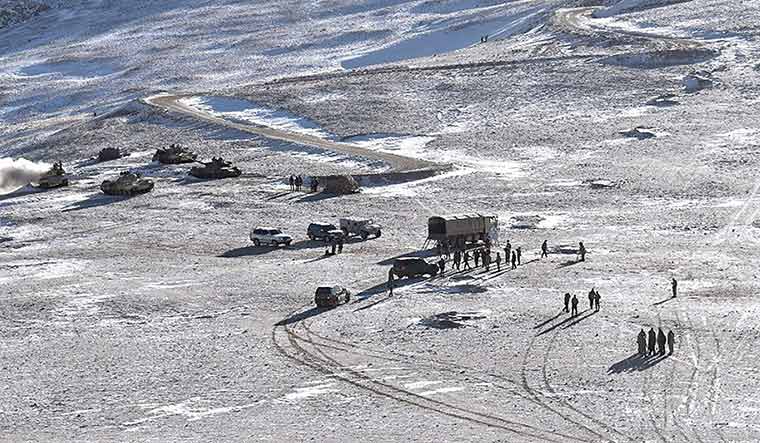Commanders of Indian and Chinese militaries are once again having discussions in an attempt to resolve the 15-month-long standoff on Eastern Ladakh. While the last meeting happened on the Indian side of the Chushul-Moldo meeting point, this time around it is at the Moldo Garrison of the People’s Liberation Army (PLA) of China.
Lt Gen P.G.K. Menon, Leh-based 14 Corps Commander, is leading the talks for the Indian side at the 12th military-level talks between Asia's two biggest militaries since June 6 last year. Both the sides had marathon meetings to chalk out the strategy to de-escalate and disengage on multiple flashpoints along the 832-km-long Line of Actual Control (LAC) in Eastern Ladakh.
A fortnight back, External Affairs Minister S. Jaishankar had a bilateral meeting with his Chinese counterpart Wang Yi on the sidelines of Shanghai Cooperation Organisation (SCO) in Dushanbe where he conveyed that unilateral change of status quo of the border area was not acceptable to India.
Military observers maintained that the Chinese military has not shown any signs of accepting the status quo ante April 2020 that India has been insisting. Instead, PLA continues to strengthen its position by deploying additional military assets, including improved efficiency of its air operations.
According to a key official in South Block, which houses the Ministry of Defence, complete disengagement of troops, weapons and equipment from Gogra and Hot Springs is the agenda of the meeting. The Chinese side, meanwhile, continues to refuse discussion on the issue of Depsang and Demchok flashpoints. Differences over agenda led to the delay in holding the military commanders' talk, as the Indian side believes that Depsang plains is the most contentious amongst all friction points, which China is not willing to discuss. Nine hundred-sq km of Depsang plains and Charding Ninglung Nallah track junction at Demchok and Patrolling point 15 are yet to be resolved.
Since 2013, China has blocked Indian patrols to Patrolling Point 10, 11, 11A, 12 and 13 Depsang plains. Chinese side even set up permanent tents in theIndian side of the border, which India has been regularly opposing.
Since April 2020, India and China have deployed a massive deployment of over 70,000 troops along with artillery, tanks and rocket elements along the border in Easters Ladakh.
Except partial disengagement on both sides of Pangong Tso, all military and diplomatic level talks have not yielded much outcome, though military negotiations have managed to control the temper of both the forces and are able to prevent a repeat of Galwan type clash.
Besides the Army, the Indian Air Force deployed its frontline fighters including newly inducted Rafale jets from France on the Ladakh sector. The IAF has just raised its new Rafale jets squadron in Hashimara, close to the China border.
The Indian military believes swift deployment of air force strike assets have somehow deterred aggressive Chinese military. The newly-inducted Chinook and Apache helicopters, along with omni-role Rafale jets, changed the dynamics on the icy heights of Himalayan frontiers, as these air assets were for the first time deployed in extreme high-altitude areas.
According to Indian military planners, they have realised that Chinese PLA can only be deterred by 'offensive' posturing. It was evident from the Indian Army's Operation Snow Leopard, launched last August to capture the dominating heights of Rezang La and Rechin La (south of Pangong Tso) on the Kailash ranges. In February, Indian forces eventually vacated these heights after the 9th Corps commander level meeting. However, some military experts believe that giving away the dominant heights on the Kailash range was a mistake as it was Chinese military's prime objective. Since then, Chinese military was not keen to resolve other points of friction.
also read
- Trump vs China could mean Rs 2 lakh crore windfall gain for India
- Beyond border acrimony, India and China agree to look at big picture
- ‘Need to focus on cooperation rather than conflict’: Rajnath Singh meets Chinese defence minister
- Jaishankar, Wang Yi discuss resuming India-China direct flight, Mansarovar Yatra
Besides Chinese aggression on Eastern Ladakh, fresh satellite images have indicated the PLA's renewed focus towards Arunachal Pradesh and Sikkim. Multiple intelligence inputs indicate PLA's infrastructure development on areas like Sikkim and Kemang sector (Tawang) with diversionary at Nakula and Fish tails. Fish Tail-1 and Fish Tail-2 are in the easternmost corners of Aruanchal Pradesh and close to McMohan Line.
Military observers are apprehensive that China may take advantage of the anticipated third wave of Covid in India. In the last couple of months, movement of Chinese troops across Arunachal Pradesh has increased manifold. It has not created military huts for its soldiers, but also created structures to settle down habitation. A few months back, Eastern Arunachal MP Tapir Gao had claimed that China had built a 100-house village deep inside Arunachal Pradesh.





